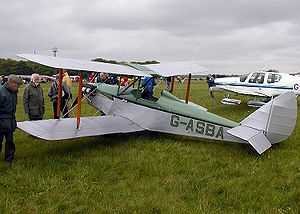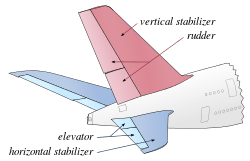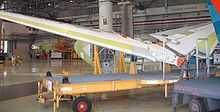Elevator (aeronautics)

Elevators are flight control surfaces, usually at the rear of an aircraft, which control the aircraft's lateral attitude by changing the pitch balance, and so also the angle of attack and the lift of the wing. The elevators are usually hinged to a fixed or adjustable rear surface, making as a whole a tailplane or horizontal stabilizer. They may be also the only pitch control surface present, sometimes located at front (early airplanes) or integrated in a rear "all-moving tailplane" also called a slab elevator or stabilator.
Elevators' effect
The wing into which elevators are hinged (the horizontal stabilizer, usually located at the rear end of an aircraft) has the opposite effect to the main wing. The horizontal stabilizer usually creates a downward force which balances the nose down moment due to the airplane's center of gravity being located in front of the center of lift, and other moments due to the effects of drag and engine thrust.
- In trim (balanced) condition, the setting of the elevator determines the airplane's trim speed - a given elevator position has only one lift coefficient (and one speed at a given altitude) at which the aircraft will maintain a constant (unaccelerated) condition.
- In control mode, the elevators change the aircraft trim and make the aircraft nose-up or nose-down.[1] The elevators decrease or increase the downward force created by the rear wing :
- an increased downward force, produced by up elevator, forces the tail down and the nose up. The increased wing angle of attack causes a greater lift to be produced by the wing and more drag, demanding more power to keep the speed or climb,
- a decreased downward force at the tail, produced by down elevator, allows the tail to rise and the nose to lower. The decrease in angle of attack reduces the lift, demanding more speed (adding power or going to a descent) to produce the required lift.
Supersonic aircraft have stabilators, because early supersonic flight research revealed that shock waves generated on the rear part of a tailplane rendered hinged elevators ineffective. Delta winged aircraft combine ailerons and elevators – and their respective control inputs – into one control surface, called an elevon.
Elevators' location
Elevators are usually part of the tail, at the rear of an aircraft. In some aircraft, pitch-control surfaces are in the front, ahead of the wing ; in a two-surface aircraft, this type of configuration is called a canard (the French word for duck) or a tandem wing. The Wright Brothers' early aircraft were of canard type ; Mignet Pou-du-Ciel and Rutan Quickie are of tandem type. Some early three surface aircraft had front elevators (Curtiss/AEA June Bug) ; modern three surface aircraft may have both front (canard) and rear elevators (Grumman X-29).
Research
Several technology research and development efforts exist to integrate the functions of aircraft flight control systems such as ailerons, elevators, elevons, flaps and flaperons into wings to perform the aerodynamic purpose with the advantages of less: mass, cost, drag, inertia (for faster, stronger control response), complexity (mechanically simpler, fewer moving parts or surfaces, less maintenance), and radar cross section for stealth. These may be used in many unmanned aerial vehicles (UAVs) and 6th generation fighter aircraft. Two promising approaches are flexible wings, and fluidics.
In flexible wings, much or all of a wing surface can change shape in flight to deflect air flow. The X-53 Active Aeroelastic Wing is a NASA effort. The Adaptive Compliant Wing is a military and commercial effort.[2][3][4]
In fluidics, forces in vehicles occur via circulation control, in which larger more complex mechanical parts are replaced by smaller simpler fluidic systems (slots which emit air flows) where larger forces in fluids are diverted by smaller jets or flows of fluid intermittently, to change the direction of vehicles.[5][6][7] In this use, fluidics promises lower mass, costs (up to 50% less), and very low inertia and response times, and simplicity.
Gallery
-

A drooped elevator, nearly touching the grass, on the horizontal stabilizer of this Currie Wot biplane .
-

The tail of an Airbus A380, showing the elevators at the rear of the horizontal stabilizer
-

Pre-installed elevators for a small Airbus. The elevator is the silver surface on the right hand side of the picture, immediately below the red pipes on the factory wall
References
- ↑ Elevator (Wordnet, Princeton University. Accessed 29-01-2009.)
- ↑ Scott, William B. (27 November 2006), "Morphing Wings", Aviation Week & Space Technology
- ↑ "FlexSys Inc.: Aerospace". Retrieved 26 April 2011.
- ↑ Kota, Sridhar; Osborn, Russell; Ervin, Gregory; Maric, Dragan; Flick, Peter; Paul, Donald. "Mission Adaptive Compliant Wing – Design, Fabrication and Flight Test". Ann Arbor, MI; Dayton, OH, U.S.A.: FlexSys Inc., Air Force Research Laboratory. Retrieved 26 April 2011.
- ↑ P John (2010). "The flapless air vehicle integrated industrial research (FLAVIIR) programme in aeronautical engineering". Proceedings of the Institution of Mechanical Engineers, Part G: Journal of Aerospace Engineering (London: Mechanical Engineering Publications) 224 (4): 355–363. doi:10.1243/09544100JAERO580. ISSN 0954-4100.
- ↑ "Showcase UAV Demonstrates Flapless Flight". BAE Systems. 2010. Retrieved 2010-12-22.
- ↑ "Demon UAV jets into history by flying without flaps". Metro.co.uk (London: Associated Newspapers Limited). 28 September 2010.
See also
External links
| Wikimedia Commons has media related to Elevators (aircraft). |
- Aircraft Pitch Motion (elevator function explanation, NASA website)
| ||||||||||||||||||||||